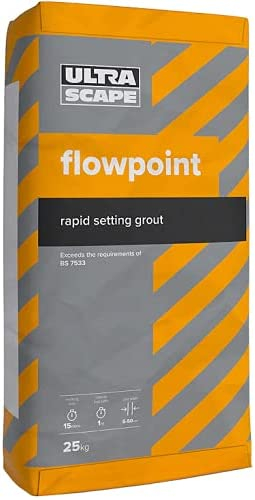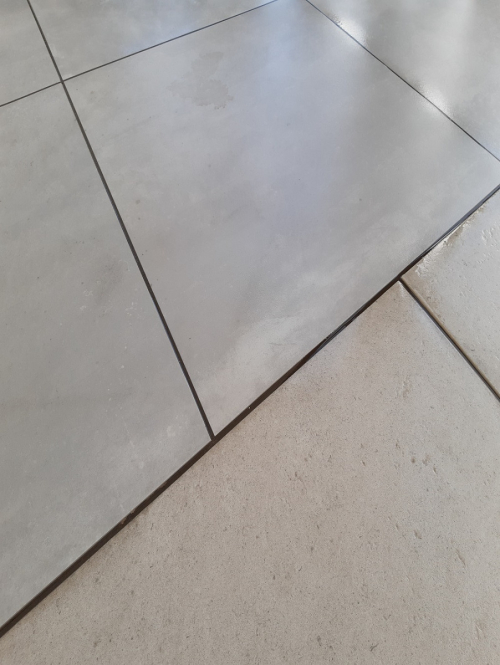Flowpoint Grout
UltraScape flowpoint grout exceeds all the requirements of the latest British Standard. It has been in use for over 20 years in a variety of project environments including public realm, landscaping and domestic. UltraScape flowpoint is synonymous with fast application, cost effective and robust jointing.
Speak to a member of our friendly sales team today on 01482 688008 or Email sales@meltonstone.co.uk
Flowpoint Grout
Is the flowpoint paving grout the best?
Determining the "best" paving grout is subjective and can depend on various factors, including the specific project requirements, personal preferences, and the characteristics of the grout itself. While Flowpoint grout is a popular and well-regarded option for many paving projects, it may not necessarily be the best choice for every situation.
Flowpoint grout has gained popularity due to its flowable consistency, rapid-setting properties, and strength. It is known for its durability and ability to provide a stable, long-lasting bond between paving stones. However, there are other grout options available in the market that may also offer excellent performance and suitability for different project requirements.
When selecting the best paving grout for your specific project, consider the following factors:
1. Application requirements: Consider the specific needs of your project, such as the type of paving material, the size and layout of the paving stones, and the anticipated foot traffic or loads. Choose a grout that is compatible with the requirements of your project.
2. Performance characteristics: Assess the performance characteristics of the grout, including strength, durability, flexibility, resistance to weathering and chemicals, and ease of application. Look for a grout that aligns with the demands of your project and the environmental conditions it will be subjected to.
3. Manufacturer's reputation and support: Research the reputation and track record of the grout manufacturer. Consider factors such as product quality, customer reviews, technical support, and availability of resources or guidance.
4. Budget considerations: Evaluate the cost-effectiveness of the grout, taking into account factors such as the overall project budget, the amount of grout required, and the expected lifespan of the installation.
To make an informed decision, it's recommended to consult with professionals, such as manufacturers, suppliers, or experienced installers, who can provide advice based on their expertise and knowledge of the specific grout options available in your area.
Ultimately, the best paving grout will depend on the specific requirements and circumstances of your project, as well as your personal priorities and preferences.
Why is flowpoint grout so strong?
Flowpoint grout is known for its strength and durability due to its unique formulation and composition. Here are a few reasons why Flowpoint grout is considered strong:
1. High-performance additives: Flowpoint grout is typically formulated with high-performance additives that enhance its strength and performance. These additives may include specialized binders, polymers, or admixtures that improve the grout's bonding properties, flexibility, and resistance to cracking or shrinkage.
2. Cementitious composition: Flowpoint grout is primarily composed of cementitious materials, such as Portland cement, which provides inherent strength and durability. Cementitious materials have excellent compressive strength and are commonly used in construction applications due to their ability to harden and withstand heavy loads.
3. Low water-to-cement ratio: The water-to-cement ratio in Flowpoint grout is carefully controlled to optimize its strength. A lower water-to-cement ratio helps minimize shrinkage and ensures proper hydration and curing of the cementitious materials, resulting in a stronger and more durable grout.
4. Rapid-setting characteristics: Flowpoint grout is designed to set relatively quickly, which allows for faster installation and reduces the risk of premature damage or displacement. Its rapid-setting properties contribute to its strength and stability.
5. Consistency and flowability: Flowpoint grout has a flowable consistency, allowing it to easily fill and bond with the joints between paving stones. The flowability ensures complete coverage and contact with the pavers, improving the overall strength of the installation.
6. Resistance to weathering and chemicals: Flowpoint grout is often formulated to be resistant to weathering elements, such as freeze-thaw cycles, UV exposure, and chemical exposure. This resistance helps maintain its strength and appearance over time, even in challenging outdoor environments.
It's important to note that the specific strength and performance of Flowpoint grout can vary depending on the manufacturer and product formulation. Always refer to the manufacturer's technical data sheets and guidelines for the specific Flowpoint grout you are using to understand its specific strength characteristics and recommended applications.
When using Flowpoint grout, it's crucial to follow the manufacturer's instructions for proper mixing, application, and curing to ensure optimal strength and performance.
How to clean off flowpoint grout stains?
Cleaning off Flowpoint grout stains can be done using a few different methods. Here are some approaches you can try:
1. Immediate cleaning: If you notice stains on the surface of Flowpoint grout shortly after installation, it's best to clean them as soon as possible. Use a damp sponge or cloth to wipe away the excess grout before it fully dries and hardens. This can help prevent more stubborn stains from forming.
2. Water and scrubbing: For fresh or mild stains, you can start by using water and a scrub brush or scrubbing pad to gently scrub the stained area. Wet the grout stains with clean water and then apply light pressure while scrubbing in circular motions. Rinse with clean water to remove any residue. This method can be effective for removing light surface stains.
3. Mild acid solution: If water and scrubbing alone do not completely remove the stains, you can try using a mild acid solution. Dilute a mild acid, such as vinegar or lemon juice, with water in a 1:1 ratio. Apply the solution to the stained grout and allow it to sit for a few minutes. Then, scrub the stains with a brush or scrubbing pad. Rinse thoroughly with clean water after scrubbing.
4. Grout cleaner: If the stains persist, you can use a commercial grout cleaner specifically designed for removing grout stains. Follow the instructions provided by the manufacturer, as different grout cleaners may have specific usage guidelines. Apply the cleaner to the stained grout, let it sit for the recommended time, and then scrub the stains with a brush or scrubbing pad. Rinse thoroughly with clean water after cleaning.
5. Professional cleaning: For stubborn or persistent stains that cannot be removed with the above methods, it may be necessary to seek professional help. Professional tile and grout cleaning services have specialized tools and cleaning solutions to effectively remove tough stains from grout.
Remember to test any cleaning solution or method in a small, inconspicuous area first to ensure compatibility and to avoid potential damage to the grout or surrounding materials. Additionally, always follow safety precautions and use proper ventilation when working with cleaning solutions or chemicals.
Regular maintenance and prompt cleaning of spills or stains can help minimize the need for extensive stain removal in the future.
Can I use a haze remover to clean off flowpoint stains?
Yes, haze remover can be used to clean off stains or residue left on the surface of Flowpoint grout. Haze removers are specifically designed to dissolve and remove grout haze, which is a thin film or residue that can develop on the surface of the grout after installation.
If you notice stains or residue on the surface of Flowpoint grout, follow these general steps to use a haze remover:
1. Read the instructions: Review the instructions provided by the haze remover manufacturer for proper usage and safety precautions. Different haze removers may have specific guidelines, so it's important to follow them accordingly.
2. Test in a small area: Before applying the haze remover to the entire stained area, it's recommended to test it in a small, inconspicuous area of the grout. This helps ensure compatibility with the grout and prevents any potential adverse reactions or damage.
3. Apply the haze remover: Apply the haze remover to the stained areas of the Flowpoint grout according to the manufacturer's instructions. This usually involves spraying or applying the solution onto the stains and allowing it to dwell for the recommended amount of time.
4. Agitate and scrub: Use a scrub brush or scrubbing pad to agitate the haze remover on the stained areas. Gently scrub the grout in circular motions to help dislodge and dissolve the stains or residue. Take care not to scrub too aggressively, as this can potentially damage the grout or the surrounding materials.
5. Rinse thoroughly: After scrubbing, rinse the area with clean water to remove the haze remover and any loosened stains or residue. Ensure that all traces of the haze remover are thoroughly rinsed off the grout.
6. Repeat if necessary: Depending on the severity of the stains or residue, you may need to repeat the process of applying the haze remover and scrubbing until the stains are completely removed. Be patient and persistent and avoid using harsh scrubbing tools or abrasive cleaners that could damage the grout.
Always follow the specific instructions and recommendations provided by the haze remover manufacturer for the best results. Additionally, consider any specific precautions or safety measures mentioned, such as using protective gloves or ensuring proper ventilation in the area where you're working.
How long does flowpoint grout take to set?
Flowpoint grout is a rapid-setting flowable grout used for filling joints between paving stones. The exact setting time of Flowpoint grout can vary depending on factors such as temperature, humidity, and the specific formulation or version of the product. However, as a general guideline, Flowpoint grout typically sets within 2 to 4 hours after application.
It's important to note that while Flowpoint grout sets relatively quickly, it may take longer for it to achieve its full strength. The full curing time can range from 24 to 48 hours or more, depending on the conditions and the manufacturer's recommendations. During this curing period, it is advisable to avoid any heavy loads or excessive traffic on the newly grouted area to allow the grout to fully harden and develop its maximum strength.
Always refer to the manufacturer's instructions and guidelines provided with the specific product you are using for the most accurate and up-to-date information on setting and curing times. Additionally, consider factors such as temperature, humidity, and any specific recommendations for your project when determining the expected setting and curing times for Flowpoint grout.



